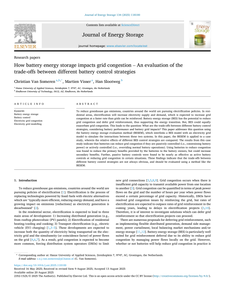To reduce greenhouse gas emissions, countries around the world are pursuing electrification policies. In residential areas, electrification will increase electricity supply and demand, which is expected to increase grid congestion at a faster rate than grids can be reinforced. Battery energy storage (BES) has the potential to reduce grid congestion and defer grid reinforcement, thus supporting the energy transition. But, BES could equally exacerbate grid congestion. This leads to the question: What are the trade-offs between different battery control strategies, considering battery performance and battery grid impacts? This paper addresses this question using the battery energy storage evaluation method (BESEM), which interlinks a BES model with an electricity grid model to simulate the interactions between these two systems. In this paper, the BESEM is applied to a case study, wherein the relative effects of different BES control strategies are compared. The results from this case study indicate that batteries can reduce grid congestion if they are passively controlled (i.e., constraining battery power) or actively controlled (i.e., overriding normal battery operations). Using batteries to reduce congestion was found to reduce the primary benefits provided by the batteries to the battery owners, but could increase secondary benefits. Further, passive battery controls were found to be nearly as effective as active battery controls at reducing grid congestion in certain situations. These findings indicate that the trade-offs between different battery control strategies are not always obvious, and should be evaluated using a method like the BESEM.
DOCUMENT

Combining electric cars with utility services seems to be a natural fit and holds the promise to tackle various mobility as well as electricity challenges at the same time. So far no viable business model for vehicle-to-grid technology has emerged, raising the question which characteristics a vehicle-to-grid business model should have. Drawing on an exploratory study amongst 189 Dutch consumers this study seeks to understand consumer preferences in vehicle-to-grid business models using conjoint analysis, factor analysis and cluster analysis. The results suggest that consumers prefer private ownership of an EV and a bidirectional charger instead of community ownership of bidirectional charger, they prefer utility companies instead of car companies as the aggregator and they require home and public charging. The most salient attributes in a V2G business model seem to be functional rather than financial or social. The customer segment with the highest willingness to adopt V2G prefers functional attributes. Based on the findings, the study proposes a business model that incorporates the derived preferences
DOCUMENT

Standard mass-production is a well-known manufacturing concept. To make small quantities or even single items of a product according to user specifications at an affordable price, alternative agile production paradigms should be investigated and developed. The system presented in this article is based on a grid of cheap reconfigurable production units, called equiplets. A grid of these equiplets is capable to produce a variety of different products in parallel at an affordable price. The underlying agent-based software for this system is responsible for the agile manufacturing. An important aspect of this type of manufacturing is the transport of the products along the available equiplets. This transport of the products from equiplet to equiplet is quite different from standard production. Every product can have its own unique path along the equiplets. In this article several topologies are discussed and investigated. Also, the planning and scheduling in relation to the transport constraints is subject of this study. Some possibilities of realization are discussed and simulations are used to generate results with the focus on efficiency and usability for different topologies and layouts of the grid and its internal transport system. Closely related with this problem is the scheduling of the production in the grid. A discussion about the maximum achievable load on the production grid and its relation with the transport system is also included.
DOCUMENT

The growing energy demand and environmental impact of traditional sources highlight the need for sustainable solutions. Hydrogen produced through water electrolysis, is a flexible and clean energy carrier capable of addressing large-electricity storage needs of the renewable but intermittent energy sources. Among various technologies, Proton Exchange Membrane Water Electrolysis (PEMWE) stands out for its efficiency and rapid response, making it ideal for grid stabilization. In its core, PEMWEs are composed of membrane electrode assemblies (MEA), which consist of a proton-conducting membrane sandwiched between two catalyst-coated electrodes, forming a single PEMWE cell unit. Despite the high efficiency and low emissions, a principal drawback of PEMWE is the capital cost due to high loading of precious metal catalysts and protective coatings. Traditional MEA catalyst coating methods are complex, inefficient, and costly to scale. To circumvent these challenges, VSParticle developed a technology for nanoparticle film production using spark ablation, which generates nanoparticles through high-voltage discharges between electrodes followed by an impaction printing module. However, the absence of liquids poses challenges, such as integrating polymeric solutions (e.g., Nafion®) for uniform, thicker catalyst coatings. Electrohydrodynamic atomization (EHDA) stands out as a promising technique thanks to its strong electric fields used to generate micro- and nanometric droplets with a narrow size distribution. Co-axial EHDA, a variation of this technique, utilizes two concentric needles to spray different fluids simultaneously.The ESPRESSO-NANO project combines co-axial EHDA with spark ablation to improve catalyst uniformity and performance at the nanometer scale by integrating electrosprayed ionomer nanoparticles with dry metal nanoparticles, ensuring better distribution of the catalyst within the nanoporous layer. This novel approach streamlines numerous steps in traditional synthesis and electrocatalyst film production which will address material waste and energy consumption, while simultaneously improve the electrochemical efficiency of PEMWEs, offering a sustainable solution to the global energy crisis.